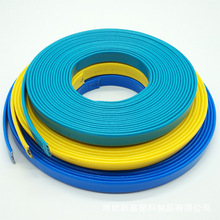Exhibition shows Danish green tech
时间:2024-09-22 07:08:06 来源:摩登家庭人人影视网 作者:关于我们 阅读:437次
Copenhagen, a pioneering city in green growth, is sharing its advanced technologies and policies in a photo exhibition at Seoul City Hall.
Detailed descriptions and images highlighting the Danish capital’s sustainable transformation over the last four decades are showcased at “Copenhagen Solutions,” which runs until Sept. 8.
The exhibition provides insights for Seoul’s citizens and government, which is vying to be Asia’s leading city in sustainable initiatives through campaigns promoting alternatives to nuclear power and a greater use of public transportation.

Denmark and Korea have stepped up collaboration in green growth in recent years, as both countries are leaders in green technology and information technology. Seoul Mayor Park Won-soon visited Copenhagen last year to bolster cooperation in public transportation and observe its bicycle infrastructure.
As Copenhagen aims to be the world’s first carbon-neutral city by 2025, it has promoted collaboration and open communication between diverse players for transparent and effective city development and management.
The combined efforts of municipalities, businesses and society have turned the dilapidated industrial city into a vibrant green city since 2000.
Denmark’s master plans target public transportation, mixed area use, social housing, energy-efficient buildings, and big data monitoring, helping to attract business with a long-term and stable investment climate.
Like most other cities around the world, Copenhagen’s growth in the latter half of the 20th century entailed severe traffic congestion and air pollution. To relieve the situation, the municipal government invested heavily in uninterrupted cycle lanes and public transportation, which continue to be key aspects of urban governance.
According to the State of Green ― a Danish green technology promotional agency ― half of all work and school trips in Copenhagen involve cycling. This has reduced travel time, noise, air pollution and carbon dioxide emissions, improving citizens’ health while reducing health care costs. Cycling-related injuries decreased by over 70 percent since 2005, thanks to bicycle-friendly infrastructure and a safe driving culture.
Copenhagen’s integrated city governance is based on a holistic partnership between planners, city councilors, architects, engineers, investors, contractors, builders and citizens.
Since the early 2000s, the city government transformed the polluted harbor into a clean recreational waterfront by modernizing the sewage system, initiating a cleaning program and constructing harbor baths. Citizens now swim, sail and fish in the Copenhagen Harbor year round. Adjacent property prices increased by nearly 60 percent and flooding risks have decreased.
As a prime example of waterfront renovation, the Nordhavnen industrial harbor, comprised of islets and canals on Copenhagen’s eastern shore, is being turned into a dense city district accommodating 40,000 residents and 40,000 work spaces.
A “smart city” prototype, it will use CO2-neutral energy solutions, smart grids, district heating and cooling, and public transit systems integrating bike paths, pedestrian walkways and subways.
All buildings in Copenhagen were required to join the district heating scheme as part of an integrated municipal energy control system since 1993. District heating is one of the most carbon-efficient ways to produce and supply energy locally, and lowers CO2 emissions by 40 percent compared to gas and 50 percent compared to oil boilers.
To combat the rising inner-city temperature from global warming, Copenhagen built two district cooling networks, which produce and distribute cooled water to buildings through underground pipelines. It reduces dependence on air-conditioning, saving 14,000 tons of carbon dioxide per year. It has also turned rooftops where air-conditioners were once stored into green gardens, helping cool the city temperature.
To reduce reliance on fossil fuels, Copenhagen has prioritized biomass technologies that generate energy by incinerating waste products. 60,000 tons of CO2 emissions are expected to be saved by the technology.
Copenhagen has partnered with the Swedish city of Malmo across the sea for regional solutions in sustainable living and commerce. The two cities are working to strengthen collaboration in innovative research, clean technology, life sciences and ICT solutions.
Copenhagen has also recently partnered Hamburg in the creative industries, climate adaptation, renewable energy, tourism, culture, and research and development.
By Joel Lee (joel@heraldcorp.com)
Detailed descriptions and images highlighting the Danish capital’s sustainable transformation over the last four decades are showcased at “Copenhagen Solutions,” which runs until Sept. 8.
The exhibition provides insights for Seoul’s citizens and government, which is vying to be Asia’s leading city in sustainable initiatives through campaigns promoting alternatives to nuclear power and a greater use of public transportation.

Denmark and Korea have stepped up collaboration in green growth in recent years, as both countries are leaders in green technology and information technology. Seoul Mayor Park Won-soon visited Copenhagen last year to bolster cooperation in public transportation and observe its bicycle infrastructure.
As Copenhagen aims to be the world’s first carbon-neutral city by 2025, it has promoted collaboration and open communication between diverse players for transparent and effective city development and management.
The combined efforts of municipalities, businesses and society have turned the dilapidated industrial city into a vibrant green city since 2000.
Denmark’s master plans target public transportation, mixed area use, social housing, energy-efficient buildings, and big data monitoring, helping to attract business with a long-term and stable investment climate.
Like most other cities around the world, Copenhagen’s growth in the latter half of the 20th century entailed severe traffic congestion and air pollution. To relieve the situation, the municipal government invested heavily in uninterrupted cycle lanes and public transportation, which continue to be key aspects of urban governance.
According to the State of Green ― a Danish green technology promotional agency ― half of all work and school trips in Copenhagen involve cycling. This has reduced travel time, noise, air pollution and carbon dioxide emissions, improving citizens’ health while reducing health care costs. Cycling-related injuries decreased by over 70 percent since 2005, thanks to bicycle-friendly infrastructure and a safe driving culture.
Copenhagen’s integrated city governance is based on a holistic partnership between planners, city councilors, architects, engineers, investors, contractors, builders and citizens.
Since the early 2000s, the city government transformed the polluted harbor into a clean recreational waterfront by modernizing the sewage system, initiating a cleaning program and constructing harbor baths. Citizens now swim, sail and fish in the Copenhagen Harbor year round. Adjacent property prices increased by nearly 60 percent and flooding risks have decreased.
As a prime example of waterfront renovation, the Nordhavnen industrial harbor, comprised of islets and canals on Copenhagen’s eastern shore, is being turned into a dense city district accommodating 40,000 residents and 40,000 work spaces.
A “smart city” prototype, it will use CO2-neutral energy solutions, smart grids, district heating and cooling, and public transit systems integrating bike paths, pedestrian walkways and subways.
All buildings in Copenhagen were required to join the district heating scheme as part of an integrated municipal energy control system since 1993. District heating is one of the most carbon-efficient ways to produce and supply energy locally, and lowers CO2 emissions by 40 percent compared to gas and 50 percent compared to oil boilers.
To combat the rising inner-city temperature from global warming, Copenhagen built two district cooling networks, which produce and distribute cooled water to buildings through underground pipelines. It reduces dependence on air-conditioning, saving 14,000 tons of carbon dioxide per year. It has also turned rooftops where air-conditioners were once stored into green gardens, helping cool the city temperature.
To reduce reliance on fossil fuels, Copenhagen has prioritized biomass technologies that generate energy by incinerating waste products. 60,000 tons of CO2 emissions are expected to be saved by the technology.
Copenhagen has partnered with the Swedish city of Malmo across the sea for regional solutions in sustainable living and commerce. The two cities are working to strengthen collaboration in innovative research, clean technology, life sciences and ICT solutions.
Copenhagen has also recently partnered Hamburg in the creative industries, climate adaptation, renewable energy, tourism, culture, and research and development.
By Joel Lee (joel@heraldcorp.com)
(责任编辑:产品中心)
最新内容
- ·护航孩子成长 解决职工后顾之忧
- ·广垦畜牧王文洲:用4.5万次种猪测定炼成的实践派育种专家
- ·There's no need to update AirPower or AirPods when you have Lana Del Rey
- ·持续整治货车“扬尘撒落”交通违法行为
- ·Pragmocracy Now
- ·'Hopefully it doesn't happen'
- ·Gymnast Aly Raisman took out a full
- ·[News Focus] Challenges remain for S. Korea’s 2nd school year under pandemic
- ·应对高温 户外驿站送清凉
- ·博罗百款预制菜亮相餐博会
热点内容
- ·Scientists discover where the huge dinosaur
- ·'Hopefully it doesn't happen'
- ·广垦畜牧王文洲:用4.5万次种猪测定炼成的实践派育种专家
- ·'Hopefully it doesn't happen'
- ·Update your BIOS: Utilities from Top Motherboard Makers
- ·North Korean defectors show support for Adrian Hong
- ·Presidential official departs for US ahead of summit
- ·'I would be disappointed if Pyongyang is rebuilding missile site': Trump
- ·The Wonderful World of Christmas Trees
- ·San Francisco Google employees walk out in protest of sexual harassment













